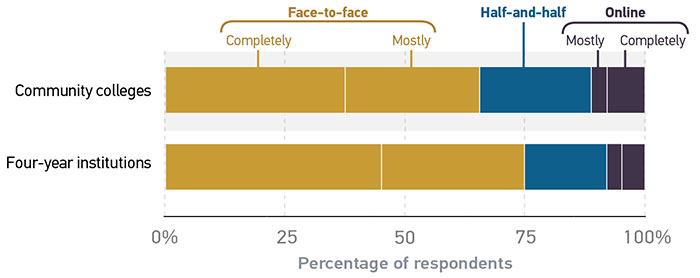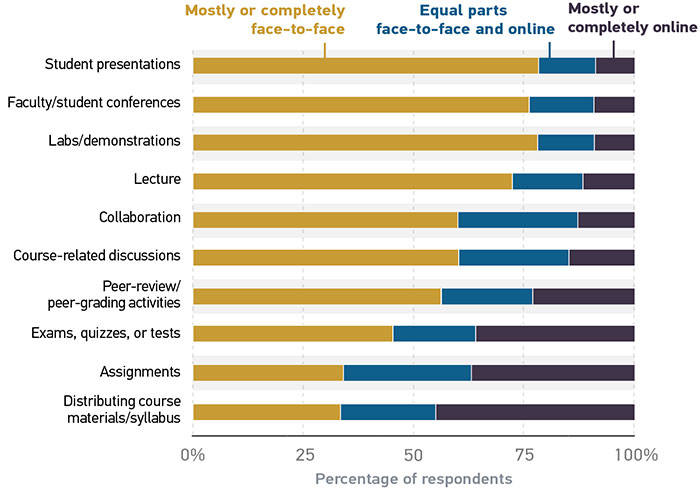Faculty Prefer Face-to-Face but Lean toward Blended and Online Environments
Online learning environments have been identified as the catalyst for nearly all increases in community college enrollment, and two-year institutions have increased online degree and certification programs over the past several years.1 Like their four-year peers, two-year students prefer blended learning overall, but two-year students are twice as likely to prefer environments that are completely online.2 Work topped the list of challenges community college students face in studying and obtaining their degree,3 and asynchronous courses can assist two-year students in balancing their competing priorities. But the number of students registering for online classes has begun to plateau.4 Although these trends suggest a slowing of online enrollment, a strong preference among community college students for online learning remains, and institutions continue to emphasize these course offerings. In light of these trends, it's important for us to understand community college faculty support for students' preferences for online environments, as well as faculty support for their institutions' continued emphasis on online learning.
More community college faculty than four-year faculty prefer teaching environments that are online or have some online component. Given the bias of our sample toward tenured or tenure-track faculty, this preference might mostly reflect this group. Nevertheless, a majority of community college faculty still prefer to teach in a face-to-face or mostly face-to-face environment (65%), though this preference is not as strong as that of their four-year colleagues (75%) (figure 3). Two-year faculty also prefer half face-to-face/half online courses (23%) more than four-year faculty do (17%). And they prefer to teach online slightly more than do instructors at four-year institutions. So it appears that two-year faculty are responding to the needs of their students by demonstrating slightly higher preferences for blended and online instruction as compared to their four-year colleagues.

Overall, a majority of two-year faculty prefer face-to-face or mostly face-to-face environments for most of their course tasks (figure 4). However, when it comes to assessments (exams, quizzes, and tests), assignments, and distribution of course materials/syllabi, a majority of two-year faculty prefer to use mostly or completely online components as compared to their other class activities.

Research suggests that institutional barriers, such as lack of technical support and lack of release time to teach online, influence faculty's preference for face-to-face courses over online environments.5 A 2016 study found that 18% of community college faculty surveyed had not received training in online instruction.6 This same study found that the number-one faculty-related challenge that distance education administrators face is engaging faculty in developing online pedagogy, along with addressing the workloads for online instruction.7 These issues might also be affecting community college faculty learning-environment preferences: they might not be receiving enough training, and this could be impacting their development of teaching strategies specific to online instruction. Online instruction has been identified as a means to expand access to higher education to the increasing numbers of nontraditional students.8 Higher education is implementing new models—in areas such as assessment (competency) and crediting (microcredentials and digital badging)—in online learning, indicating an expanded need for faculty teaching skills in blended and online environments.9 To address these trends, community colleges might need to provide more support for engaging in online or blended learning environments so that faculty can respond to current and future needs of their institution and their students.
Notes
-
Carl Straumsheim, "Stopping Stop-Outs," Inside Higher Ed, April 13, 2016.
↩︎ -
Dana C. Gierdowski, ECAR Study of Community College Students and Information Technology, 2019, research report (Louisville, CO: ECAR, May 28, 2019).
↩︎ -
Ashley A. Smith, "What Community College Students Say Impedes Their Progress," Inside Higher Ed, February 12, 2019.
↩︎ -
This plateau is attributed to an improving economy, so prospective students might not be enrolling in classes. See, for example, Lokken, Trends in eLearning.
↩︎ -
Loréal L. Maguire, "Literature Review–Faculty Participation in Online Distance Education: Barriers and Motivators," Online Journal of Distance Learning Administration 8, no. 1 (2005): 1–16.
↩︎ -
From faculty surveyed in 2016. See Lokken, Trends in eLearning.
↩︎ -
Ibid.
↩︎ -
Malcolm Brown, Mark McCormack, Jamie Reeves, D. Christopher Brooks, and Susan Grajek, with Bryan Alexander, Maha Bali, Stephanie Bulger, Shawna Dark, Nicole Engelbert, Kevin Gannon, Adrienne Gauthier, David Gibson, Rob Gibson, Brigitte Lundin, George Veletsianos, and Nicole Weber, 2020 EDUCAUSE Horizon Report: Teaching and Learning Edition (Louisville, CO: EDUCAUSE, 2020).
↩︎ -
Ibid.
↩︎